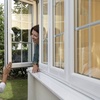When considering window installation, understanding the various factors influencing costs is crucial for effective budgeting. From the type of windows to labor expenses, several elements contribute to the overall price. This comprehensive guide explores the diverse aspects affecting window installation costs, empowering homeowners with the knowledge needed to make informed decisions.
Materials:
Investigating the type and quality of materials is paramount to determining installation costs. High-quality materials like energy-efficient windows may initially seem pricier but can result in long-term savings through reduced energy bills.
Window frames: The material of the frame significantly impacts costs. Options range from economical vinyl to high-end wood or aluminum frames, each with its own set of pros and cons.
Glass quality: The type of glass selected, such as double or triple-pane windows, impacts insulation and energy efficiency, influencing both upfront costs and long-term savings.
Labor Costs:
Skilled labor is a significant component of window installation expenses. Factors such as experience level, location, and project complexity can all affect labor costs.
Professional Installation: Hiring experienced professionals ensures proper installation, reducing the likelihood of future repairs or replacements and ultimately saving money in the long run.
Location: Labor costs vary regionally due to differences in demand, cost of living, and local regulations. Urban areas often have higher labor rates compared to rural areas.
Window Type and Size:
The type and size of windows directly correlate with installation expenses. Larger or custom-designed windows typically require more labor and materials, driving up costs accordingly.
Standard vs. Custom Windows: While standard-sized windows are more cost-effective due to mass production, custom-designed windows offer unique aesthetics but often come with a higher price tag.
Number of Windows: The quantity of windows being installed influences the overall project cost, as each additional window increases material and labor expenses.
Additional Features:
Incorporating additional features into window installations can enhance functionality and aesthetics but also add to the total project cost.
Energy Efficiency Upgrades: Opting for energy-efficient features such as Low-E coatings or argon gas fills can increase upfront costs but result in long-term savings on energy bills.
Decorative Elements: Choosing decorative elements like grids or specialty glass can enhance curb appeal but typically come at an additional cost.
Warranty and Maintenance:
Considering warranty coverage and future maintenance requirements is essential for assessing the overall value of a window installation project.
Warranty Options: Investigating warranty coverage provided by manufacturers and installers ensures protection against defects and installation errors, offering peace of mind to homeowners.
Maintenance Considerations: Understanding the maintenance requirements of different window materials and features helps homeowners anticipate future upkeep costs and prolong the lifespan of their windows.
Financing Options:
Exploring financing options can help homeowners manage the upfront costs of window installation projects, making them more accessible and affordable.
Payment Plans: Many contractors offer flexible payment plans or financing options to accommodate varying budget constraints, allowing homeowners to spread out the cost over time.
Government Incentives: Researching available government incentives or rebates for energy-efficient window installations can offset upfront expenses and provide additional savings.
Conclusion:
In conclusion, several factors influence the cost of window installation, from materials and labor to additional features and warranties. By understanding these key elements, homeowners can make informed decisions that align with their budgetary constraints and long-term goals. Investing in quality materials and professional installation can lead to enhanced energy efficiency, aesthetic appeal, and overall value for your home.
Visit Website: https://whiteeagle-windowsanddoors.co.uk/
FAQs:
-
How do I determine the right window materials for my budget? Quality and longevity are essential factors when considering window materials. While upfront costs may vary, opting for durable materials can result in long-term savings.
-
Are there any DIY options for window installation to save money? While some homeowners may consider DIY installation to save money, it's essential to weigh the risks carefully. Improper installation can lead to air leaks, moisture issues, and reduced energy efficiency, ultimately costing more in repairs.
-
Can I negotiate pricing with window installation contractors? Yes, negotiating pricing with contractors is common practice. However, ensure that any negotiated discounts do not compromise the quality of materials or installation.
-
Are there any financing options available for window installation projects? Many contractors offer financing options or payment plans to help homeowners manage the upfront costs of window installations. Additionally, research government incentives or rebates for energy-efficient upgrades.
-
How long does a typical window installation project take? The duration of a window installation project varies depending on factors such as the number of windows, their size, and any additional features. On average, installation can take anywhere from a few days to a couple of weeks.


No comments yet